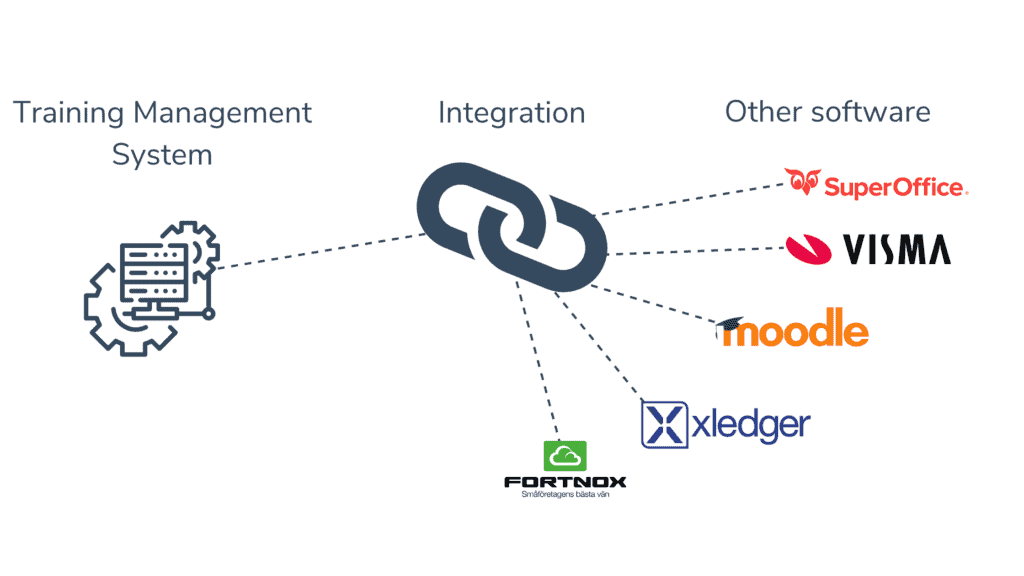Have you ever found yourself in a situation where you spend hours moving data from program to program? If so, wouldn’t it be easier if you and your team could focus on building an even better training business? With integrations you can do just that!
What are integrations?
So, what is system integration? It is a type of connection between two or more systems that don’t initially communicate, that make them work together as one united system. There are numerous disadvantages to running multiple software applications without integrating them. Are you thinking about investing in an integrated system? In that case, here are a few benefits of system integration and how they can improve your business.
Productivity and Efficiency
Having an integrated system can help improve efficiency by removing the need for repetitive manual data entry. Employees can receive accurate data for further processing because the system automatically updates the central database. As a result, this helps you save a significant amount of time.
Improved Work Culture
Avoiding burnout amongst your employees is particularly an important part of a business. Burnout happens firstly, because employees feel like they have to work harder and secondly, working hard without making any real progress. Mind-numbing tasks like manual data entry and finding documents pile up will subsequently leave your employees stressing to find time to focus on high-level tasks.
By integrating your systems, you’ll reduce your employees workload and they will be less stressed. As a result, they’ll have more time to focus on tasks that can grow your business. This will make their work feel more meaningful and improve the overall work culture.
Reduced Bottlenecks
What are bottlenecks? A bottleneck in a business is a point of congestion in a production system that stops or severely slows the system. In other words, bottlenecks are unable to process all of the work items quickly enough to get them to the next stage in operation without causing some sort of delay. The inefficiencies brought about by the bottleneck often create higher production costs. Bottlenecks can occur for any number of reasons, from human error to poor systems management. Or in this case, non-integrated systems.
Inefficient systems mean more slowdowns. From communication delays to siloed data, the ability for a large organization to act quickly with multiple different systems is greatly reduced. Integrated systems break down those bottlenecks and reduce the need for unnecessary back and forth. This results in greater efficiency across your organization
Improved Data Security
Spreadsheets aren’t secure. Even if they’re password-protected, anyone with access to that password can access all of your customer data. All it takes is one miss sent email or an employee to click on the wrong link, and you have a major data breach on your hands.
Integrated systems remove the need to use spreadsheets to capture data. Instead, your sensitive information is collected into a secure database.
Save Time and Money
As mentioned above, with an integrated system you can complete tasks more efficiently. As a result, you can reduce unnecessary costs. Integrated systems remove the need for simple tasks, giving your employees more time to focus on what really matters. Best of all, you’ll need fewer employees to manage these tasks. That means you’ll keep your business lean and scalable without overworking your staff.
Who needs integrations?
Integrations are useful tools for virtually any business, regardless of size or industry. There are integrations suited for every type of company (startups, training businesses, and enterprise companies) with any purpose (advertising, analytics, or content).
For course providers, integrations are the link that makes it possible to get all the best systems – and make them talk to each other. There are several types of data you as a course provider can benefit from being moved automatically between systems, and I will give some examples of the most popular uses here. But it goes to say that integrations are incredibly versatile and can be used for much more than what’s on this list!
Also read: How integrations makes your training business more efficient
Get started today
I hope you found this blog post helpful and learned something about what integrations are and how your business can benefit from it. If you want more information about FrontCore’s training administration system and which integrations the system can be connected to, you can read about FrontCore’s integrations here!
Did you like this article? Don't forget to share it:










0 Comments